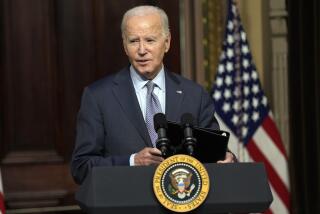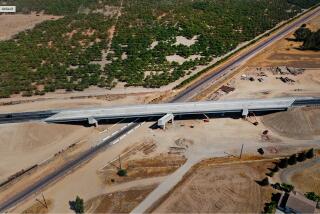States to Offer Proposals on $5.3-Billion Project : Contest for Huge Atom Smasher to Begin
- Share via
WASHINGTON — The U.S. Department of Energy on Tuesday fired the opening gun in what promises to be a spirited contest among states for the most costly basic research project in the nation’s history, a $5.3-billion atom smasher called the Superconducting Super Collider.
Secretary of Energy John S. Herrington said the department will begin accepting formal site proposals in April from state governments interested in providing a home for the machine, a nuclear-particle accelerator 52 miles in circumference that the Reagan Administration says will ensure American pre-eminence in high-energy physics into the next century.
In addition to direct economic benefits from the construction project, the winning state would acquire a prestigious new research center of global importance, with added gains for regional universities and a boost for local high-technology industries.
Congress Has Not Acted
The Administration, however, has yet to seek congressional approval for the super-collider, and apparently will not confront that hurdle until next year, when it asks for $348 million in the fiscal 1989 budget, the last that the Reagan Administration will submit.
Officials said that $35 million will be spent on research and development for the project in fiscal 1988 but that this will come from within the Administration’s pending budget request. A funding schedule the Department of Energy released at a news conference Tuesday shows the project’s budget rising to $348 million in fiscal 1989 as construction begins, and peaking at $709 million in fiscal 1994. The project would be completed in 1996.
Despite the absence of congressional endorsement, Herrington spoke of the super-collider project with a tone of certainty. Calling it a “beacon for America’s science and technology,” he said it “will be a valuable training ground for American scientists and an attraction for many of the world’s leading scientists to live and work in the United States.”
Skepticism Seen
Although he said it has won President Reagan’s enthusiastic support, Herrington indirectly acknowledged skepticism about the project within the Administration. In trying to sell it to the White House Office of Management and Budget last month, he said, he felt like Christopher Columbus standing before Queen Isabella’s budget director.
Nearly every state has expressed interest in acquiring the super-collider, Herrington said. Among states that have been most aggressive in preparing preliminary site proposals, some spending several million dollars so far in planning, he listed Texas, California, Illinois, Utah, Colorado and Washington. Herrington and other officials insisted, however, that no state can be considered to have a natural advantage and that all proposals will go through a rigorous screening process.
Selection Process
State applications are to be accepted between April and August. Those meeting minimum requirements, yet to be spelled out, will be passed on for detailed evaluation to a special panel of the National Academy of Sciences and the National Academy of Engineering. The academies are to recommend “a few” of the most suitable sites, from which the secretary of energy is to select a “preferred” site by July, 1988. Final site selection would take place in January, 1989.
The super-collider would consist of a 10-foot-wide tunnel built in the shape of a race track 52 miles in circumference. About 10,000 supercooled magnets inside the tunnel would guide two accelerating beams of protons that would collide at energies of 40 trillion electron volts, 20 times the energies achievable with existing machines.
Herrington discounted as “highly speculative” suggestions by some scientists that project costs could be cut by $500 million if the super-collider is built at the Fermilab facility in Illinois, where an existing accelerator, now the nation’s largest, could give the new machine’s proton beams an initial boost.
He said at least two states, which he declined to name, already have offered to offset this potential advantage with other economic inducements. Other scientists, Herrington said, have also advised that tailoring the new machine to accommodate an existing accelerator could be an expensive mistake.
More to Read
Sign up for Essential California
The most important California stories and recommendations in your inbox every morning.
You may occasionally receive promotional content from the Los Angeles Times.










